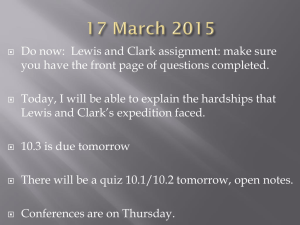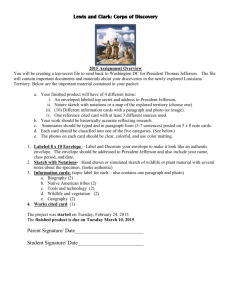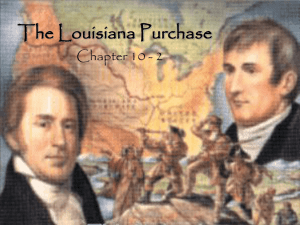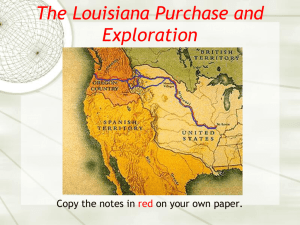Lewis and Clark Expedition Report (1806)
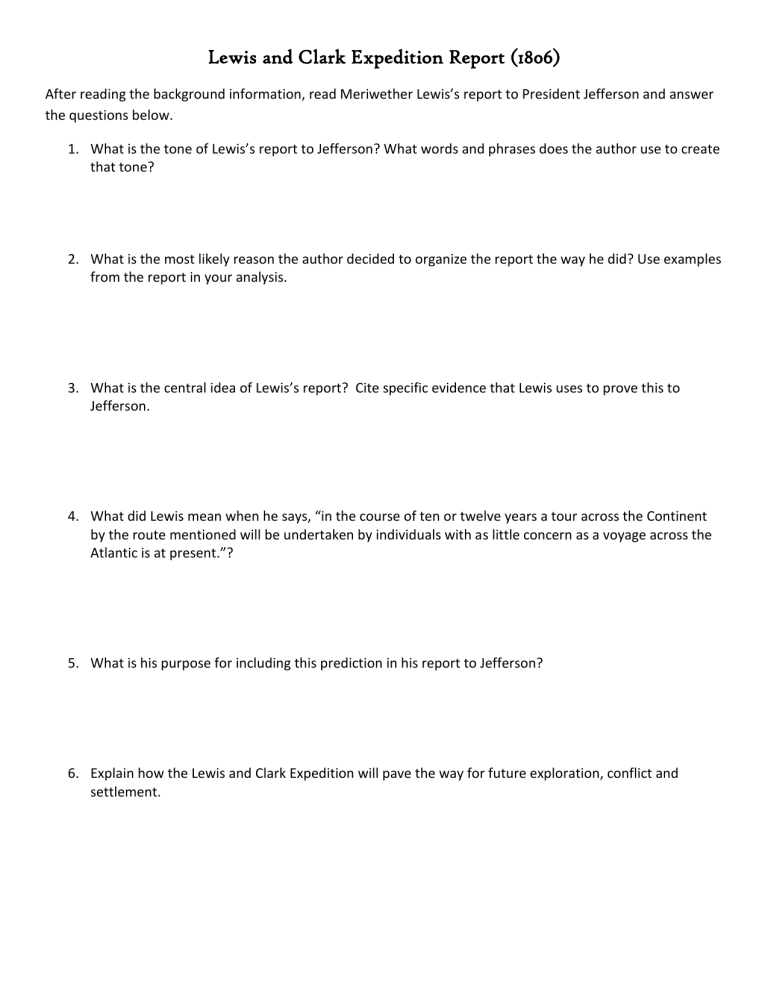
Lewis and Clark Expedition Report (1806)
After reading the background information, read Meriwether Lewis’s report to President Jefferson and answer the questions below.
1.
What is the tone of Lewis’s report to Jefferson? What words and phrases does the author use to create that tone?
2.
What is the most likely reason the author decided to organize the report the way he did? Use examples from the report in your analysis.
3.
What is the central idea of Lewis’s report? Cite specific evidence that Lewis uses to prove this to
Jefferson.
4.
What did Lewis mean when he says, “in the course of ten or twelve years a tour across the Continent by the route mentioned will be undertaken by individuals with as little concern as a voyage across the
Atlantic is at present.”?
5.
What is his purpose for including this prediction in his report to Jefferson?
6.
Explain how the Lewis and Clark Expedition will pave the way for future exploration, conflict and settlement.
Lewis and Clark Expedition
(1806)
In 1803, President Thomas Jefferson asked the U.S. Senate to authorize the purchase of a huge tract of land from France. Known as the Louisiana Purchase, the area stretched from the Mississippi River westward to the
Continental Divide in the Rocky Mountains. Not included was Spain’s territory in the Southwest and disputed territory in Oregon. For some time, Jefferson pondered the legality of this acquisition. He wanted to see the nation grow. But he was not sure that the U.S. Constitution gave the government the power to buy land. The
Senate seemed to have no such difficulty and quickly ratified the purchase.
Jefferson named Meriwether Lewis, his former personal secretary, and Captain William Clark to lead an expedition to explore the territory. They left in the spring of 1804 from St. Louis and went up the Missouri River.
One member of the expedition was York, an enslaved African American who was Clark’s servant. On the way,
Lewis and Clark hired Pierre Charbonneau as interpreter and guide. Charbonneau’s wife Sacagawea, a
Shoshone, helped the expedition deal with Native Americans it met along its route. She also served as an interpreter and guide. The following is an excerpt from Lewis’s 1806 report to Jefferson, sent when Lewis returned to St. Louis.
It is with pleasure that I announce to you the safe arrival of myself and party at 12 o'clock today.... In obedience to your orders we have penetrated the continent of North America to the Pacific Ocean, and sufficiently explored the interior of the country to affirm with confidence that we have discovered the most practicable route which does exist across the continent by means of the navigable branches of the Missouri and Columbia Rivers. .
The Missouri and all its branches from the Cheyenne upwards abound more in beaver and common otter, than any other streams on earth, particularly that proportion of them lying within the Rocky Mountains. The furs of all this immense tract of country including such as may be collected on the upper portion of the River
St. Peters, Red River, and the Assinniboin with the immense country watered by the Columbia, may be conveyed [brought] to the mouth of the Columbia by the 1st of August in each year and from thence be shipped to, and arrive in Canton [China] earlier than the furs at present shipped from Montreal annually arrive in London. . . .
Although the Columbia does not as much as the Missouri abound in beaver and otter, yet it is by no means despicable [hateful] in this respect, and would furnish a valuable fur trade distinct from any other consideration in addition to the otter and beaver which it could furnish. There might be collected considerable quantities of the skins of three species of bear affording a great variety of colours and of superior delicacy
[quality], those also of the tiger cat, several species of fox, martin and several others of an inferior class of furs, besides the valuable sea otter of the coast.
If the government will only aid, even in a very limited manner, the enterprise of her citizens I am fully convinced that we shall shortly derive [obtain] the benefits of a most lucrative [profitable] trade from this source, and that in the course of ten or twelve years a tour across the continent by the route mentioned will be undertaken by individuals with as little concern as a voyage across the Atlantic is at present.
